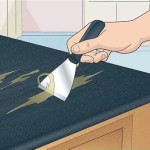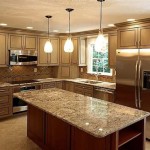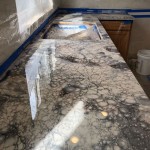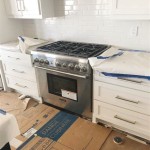How Thick Should a Concrete Countertop Be?
Determining the appropriate thickness for a concrete countertop is a crucial decision that influences its structural integrity, aesthetic appeal, and overall functionality. Several factors contribute to the ideal thickness, ranging from the countertop's intended use and support structure to the desired aesthetic and the type of reinforcement employed. A well-considered thickness ensures longevity and mitigates the risk of cracking, warping, or other forms of damage. This article will explore the key considerations and provide a comprehensive understanding of how to determine the optimum thickness for concrete countertops.
Understanding Structural Considerations
The primary function of a countertop is to provide a durable and stable surface for a variety of tasks. The thickness of the concrete directly impacts its ability to withstand the weight and stress imposed upon it. A thinner countertop may be more prone to cracking under heavy loads, while an excessively thick countertop may be unnecessary and add excessive weight. The span between supports is a critical factor. Larger spans demand greater thickness to prevent sagging or bending. Conversely, countertops with frequent supports can often be thinner without compromising structural integrity.
The type of support structure also plays a significant role. A fully supported countertop, where the entire underside rests on cabinets or a solid base, can generally be thinner than a cantilevered countertop that extends beyond its support. Cantilevered sections require increased thickness to resist the bending forces created by the unsupported overhang. In such cases, additional reinforcement, such as steel rebar or fiber reinforcement, may be necessary to enhance the countertop's load-bearing capacity.
Another structural consideration is the presence of cutouts for sinks, cooktops, or other appliances. These cutouts weaken the countertop and can create stress concentrations around the edges. To compensate for this, the concrete surrounding the cutouts may need to be thicker or reinforced. Reinforcement can be strategically placed to provide additional support and prevent cracking in these vulnerable areas. The size and location of the cutout will dictate the necessary adjustments to the countertop's thickness and reinforcement strategy.
The type of concrete mix used also influences the required thickness. High-strength concrete mixes, which contain a higher proportion of cement and carefully selected aggregates, can achieve greater strength and durability at a given thickness compared to weaker mixes. The use of admixtures, such as plasticizers and superplasticizers, can further enhance the workability and strength of the concrete, potentially allowing for thinner countertop designs. However, even with high-strength concrete, proper reinforcement and support are essential for long-term performance.
Aesthetic Considerations in Countertop Thickness
While structural integrity is paramount, the aesthetic appeal of a concrete countertop is also an important consideration. The thickness of the countertop contributes significantly to its overall visual impact and can influence the perceived style of the kitchen or bathroom. Thicker countertops often convey a sense of solidity and permanence, while thinner countertops can appear more modern and streamlined. The choice of thickness should align with the overall design aesthetic of the space.
The edge profile of the countertop is another factor that interacts with the thickness. A thicker countertop can accommodate more elaborate edge profiles, such as bullnose, ogee, or chiseled edges, which add visual interest and detail. Thinner countertops may be limited to simpler edge profiles, such as square or slightly rounded edges. The desired edge profile should be considered when determining the overall thickness of the countertop.
The color and texture of the concrete can also influence the perceived thickness of the countertop. Darker colors tend to make objects appear smaller, while lighter colors can make them appear larger. Similarly, rough textures can make a countertop appear more substantial than smooth, polished surfaces. These visual effects can be used to fine-tune the overall aesthetic of the countertop and create the desired impression of thickness.
Ultimately, the aesthetic considerations for countertop thickness are subjective and depend on the personal preferences of the homeowner or designer. However, it is important to carefully consider these factors alongside the structural requirements to ensure that the final result is both visually appealing and structurally sound. Balancing aesthetic desires with practical needs is key to a successful concrete countertop installation.
Reinforcement Strategies and Their Impact on Thickness
Reinforcement plays a critical role in the performance of concrete countertops, particularly in thinner designs or those with large spans or cantilevered sections. Reinforcement materials, such as steel rebar, wire mesh, or fiber reinforcement, enhance the tensile strength of the concrete and prevent cracking under stress. The type and amount of reinforcement used can significantly impact the required thickness of the countertop.
Steel rebar is a common form of reinforcement for concrete countertops, particularly for larger installations. Rebar provides excellent tensile strength and helps distribute stress throughout the concrete. The size and spacing of the rebar are determined by the countertop's dimensions, the expected load, and the presence of any cutouts or overhangs. Strategically placed rebar can significantly reduce the risk of cracking and allow for thinner countertop designs.
Wire mesh is another option for reinforcing concrete countertops. Wire mesh consists of a grid of interconnected steel wires that provide a uniform distribution of reinforcement throughout the concrete. Wire mesh is particularly effective in preventing surface cracking and improving the overall durability of the countertop. It is often used in conjunction with other forms of reinforcement, such as rebar, to provide comprehensive protection.
Fiber reinforcement is a relatively new technology that involves adding small fibers, typically made of glass, polypropylene, or steel, to the concrete mix. These fibers enhance the concrete's tensile strength and reduce its susceptibility to cracking. Fiber reinforcement is particularly effective in preventing shrinkage cracking, which can occur during the curing process. It can also improve the impact resistance of the countertop. In some cases, fiber reinforcement can be used as a primary reinforcement method, allowing for thinner countertop designs.
The choice of reinforcement strategy will depend on the specific requirements of the countertop. Factors to consider include the countertop's size, shape, support structure, and the desired aesthetic. A qualified concrete contractor can assess these factors and recommend the appropriate reinforcement strategy and the corresponding countertop thickness. Proper reinforcement is essential for ensuring the long-term performance and durability of concrete countertops.
The thickness of a concrete countertop should also account for the potential for surface imperfections or variations. While achieving a perfectly level surface is the goal, slight variations in thickness can occur during the casting and finishing process. To compensate for this, it is generally advisable to add a small amount of extra thickness to the countertop. This provides a buffer that allows for grinding and polishing without compromising the structural integrity of the countertop.
In addition to the structural and aesthetic considerations, the practical aspects of handling and installation should also be taken into account. Thicker countertops are heavier and more difficult to move and install. This can increase the cost of labor and require specialized equipment. Thinner countertops are lighter and easier to handle, but they may be more vulnerable to damage during transportation and installation. The optimal thickness should strike a balance between ease of handling and structural integrity.
Ultimately, determining the appropriate thickness for a concrete countertop requires a careful assessment of all relevant factors, including structural requirements, aesthetic preferences, reinforcement strategies, and practical considerations. Consulting with a qualified concrete contractor is highly recommended to ensure that the final result is both visually appealing and structurally sound. A well-designed and properly installed concrete countertop can provide years of durable and beautiful service.
Finally, it is important to consider the long-term maintenance of a concrete countertop when determining its thickness. Concrete is a porous material and can be susceptible to staining and damage from spills. Thicker countertops provide more material for resurfacing and refinishing, which can extend the lifespan of the countertop and maintain its appearance over time. Applying a high-quality sealant is essential for protecting the concrete from stains and moisture, but even with proper sealing, periodic maintenance may be required.

Rebar Size In Concrete Countertops Free Training

Concrete Countertops Faq Fine Homebuilding

Concrete Worktops How Thick Should They Be Fluid Stone Studio

Diy Concrete Countertops Easy Step By Guide Run To Radiance

How To Reinforce Your Concrete Countertop Decor

Concrete Countertops Pros Cons Diy Care Network

How To Build A Concrete Countertop

Diy Concrete Countertops Part I Setting The Forms Wildfire Interiors

How To Make Concrete Countertops Tutorial Ping List Photos

How To Diy Concrete Countertops Over Old Laminate Bless Er House
See Also








